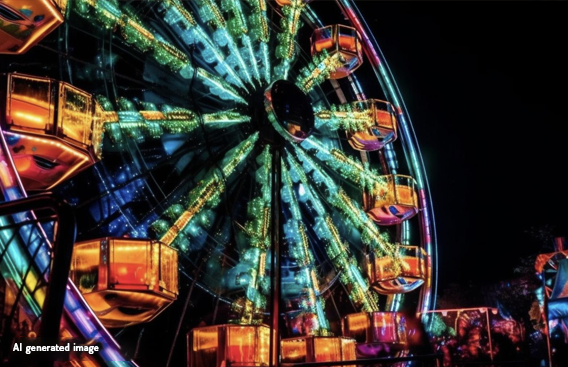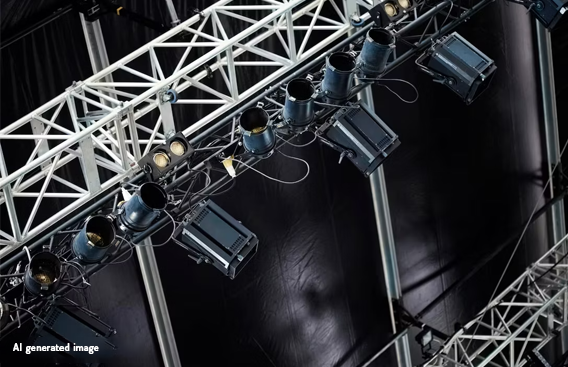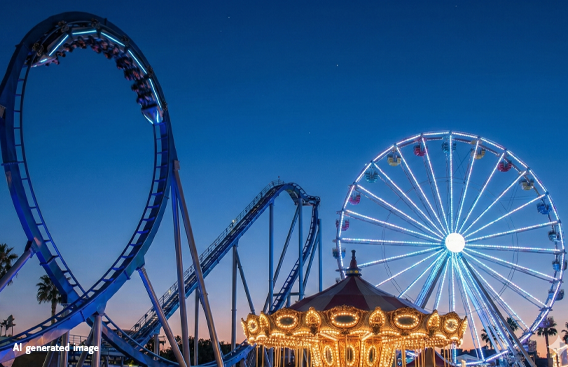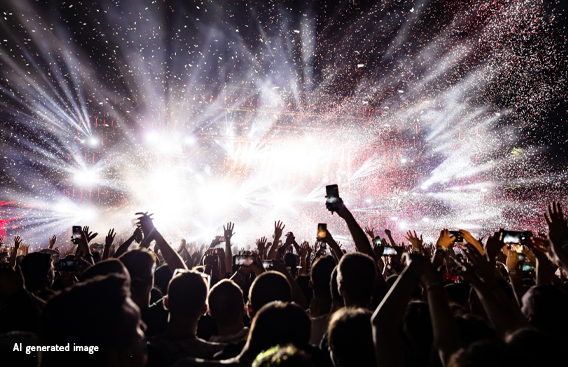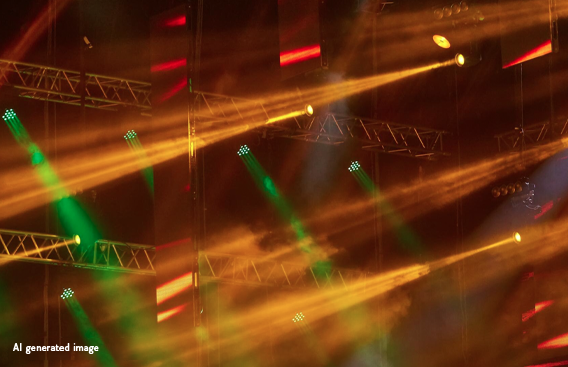Are theme park rides safe? What you should know if you’re worried about accidents.
Whenever there’s a serious theme park accident, it gets widespread attention and the quiet voice in some people’s minds gets a little louder: What if something goes wrong when I ride?
It’s highly unlikely.
By and large, theme park attractions are incredibly safe. To understand how safe, we turned to two industry leaders.
- Jakob Wahl is president and CEO of the International Association of Amusement Parks and Attractions. IAAPA’s members span every size and sector of the attractions industry, from theme park operators to merchandising.
- Jim Seay is president and owner of Premier Rides, which designs and manufactures attractions for the likes of SeaWorld, Universal Studios and Six Flags. Seay also chaired ASTM’s Committee F24 on Amusement Rides and Devices, a global committee that sets industry standards for attraction safety, and the IAAPA Global Safety Committee.
How common are amusement park accidents?
There were an estimated 130 serious ride-related injuries at North American theme parks in 2021, according to the National Safety Council’s latest ride safety report for IAAPA. Those include fatalities as well as injuries requiring immediate hospitalization for more than 24 hours for reasons beyond observation.
For perspective, 658 people died in boating-related accidents that same year, according to U.S. Coast Guard numbers shared by the Centers for Disease Control and Prevention. Another 42,915 people were killed in motor vehicle accidents, according to the National Highway Traffic Safety Administration. Neither of those tallies include nonfatal injuries.
„Incidences that are extremely severe are very rare in our industry,“ said Seay, adding that’s why they draw attention – „because it is so rare.“
Based on data collected from parks, IAAPA estimates the odds of being seriously injured on a fixed-site ride at a U.S. amusement park are 1 in 15.5 million rides taken.
„We really dedicate a lot of time to safety, not because it’s a problem but just to make sure that it stays as safe as it is today,“ Wahl said. „If people don’t feel safe, then we have a problem.“
Are theme park rides safe?
Overwhelmingly, yes. „Safety is at the forefront of everything we do,“ Wahl said.
Even new cutting-edge thrill rides marketed as the fastest, longest or steepest have to follow safety standards set by industry experts.
„The ASTM standards prescribe very detailed G-force levels that have to be achieved in order for a ride to be considered safe,“ Seay said as an example. He noted that states generally codify ASTM guidelines as part of their own regulations instead of crafting their own.
From the get-go, Seay said, attractions are designed with those standards in mind; then „every millimeter of the attraction“ is tested on computers before anything is built in the real world. Once an attraction is built, he said, it goes through extensive testing with sensor-loaded dummies, like those in automobile crash tests, before safety personnel ride it. Meanwhile, attraction operators are heavily trained in operating the rides, and they get tested on their knowledge as well. The ride then soft-opens to a limited group, like fellow park employees or annual passholders, and is fine-tuned before opening to the general public.
„There is a very thorough engineering and manufacturing process, but also the operation process is very thorough,“ Wahl said. There are all sorts of inspections.
How are roller coasters tested for safety?
„We have very detailed, very prescriptive requirements for inspections,“ Seay said. He said each ride is tested every day of operation. On top of that, separate weekly and monthly inspections are done to check for various things, including wear and tear. „Those rides have hundreds if not thousands of electronic inputs and outputs that are showing the status of the entire ride on a very individual basis. They’re all tested.“
Additionally, he said, state regulators, independent third parties hired by park operators, and insurance companies test attractions along different timetables.
„It would be surprising to a lot of guests how many levels of inspections are actually occurring,“ he said. „But the guests never see that. When you go to a theme park, the whole idea is to enjoy yourself and not focus on the level of inputs that are going on.“
What does it mean when a ride is temporarily closed?
Wahl likened attractions to big machines with huge IT structures. „It’s a very complicated system with many sensors to exactly ensure that our guests can enjoy safe fun.“ And just as with computers or smartphones, he said, „sometimes the system is needing an update or checking on what is going on or gets halted.“
„It might sound strange, but this is actually a good sign, because if a vehicle is stopped on the lift hill or on a brake, it means that the ride system signalizes ‚Hey, something here is maybe not 100% correct, so we will check on that, and this is why we are holding the car,‘ “ he said. „It actually proves that the system is working.“
Checking everything out takes time.
„This is where all parks have very, very detailed safety protocols,“ Wahl said. „It usually takes the maintenance crew, the engineering crew, to go to the ride, check on it, to reboot it actually and to make sure that everything is fine before we let passengers again on the ride. … We just want to do our due diligence to make sure that once we open it again that everything in the system works properly.“
What happens if there’s an accident?
If a serious incident occurs, Seay said, parks will typically notify state authorities and the ride’s manufacturers, who work together, often with third parties brought in by either regulators or park operators, to determine the cause.
„Mechanical and electrical failures end up being probably the smallest component of what can create an incident,“ he said. But if it turns out to be related to a mechanical failure, he said, „we would have both a moral duty plus a business duty and standards duty to inform other people that have similar equipment. And if someone has the same ride at another park, we would inform them of that and would detail what steps need to be taken before they continue to operate that ride.“
Wahl said: „Rides can reopen if all tests, if all investigation has shown positively that it was not a failure of the ride system itself.“ In some cases, park operators may still choose to permanently close a ride after a serious accident. „If a ride reopens, I can guarantee you that several investigations have been made, that safety inspectors have looked at the ride, and that all checks have been done in a way that it is safe to reopen.“
ASTM and IAAPA widely share any lessons learned to ensure „no mistake happens twice,“ according to Wahl. Seay added that while theme park operators and manufacturers can be highly competitive when it comes to things like developing new attractions or other trade secrets, they are exceptionally open and collaborative when it comes to sharing tips to improve safety for everyone.
How do you stay safe on rides?
„There are very distinct guidelines on what you need to do to have a safe experience, and if people are purposely not following those guidelines, that that puts not only the rider at risk, but it puts other riders at risk,“ Seay said.
That begins even before boarding a ride.
„I’m sure you’ve been on a ride where you go up and it says, ‚If you have the following conditions, you should not ride the ride,‘ “ he said. „There’s obviously not a way for the park to medically check each person. … The rider needs to look at those list of items and determine if the right is appropriate for them.“
To help guests determine their own safety, many thrill rides also offer test seats outside the attraction. „You can see: ‚Can I fit into this right? Is this right actually safe for me?‘ “ Wahl said. „Then you also notice when you go to the station that we have the operators giving you safety instructions, you know: ‚Keep your arms and legs inside the car.‘ … All of those things flow into the safe operation of an attraction.“
Don’t break the rules, especially for internet clout. „Some people will take advantage of the opportunities of having social media to show inappropriate behavior,“ Seay said.
Said Wahl: „If you follow the procedures of the safety instructions, you really don’t need to worry about something happening to you.“
[USA Today – original article]
[Picture – Javier Zarracina – USA Today]
